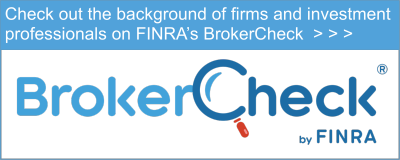September 2017 Newsletter
| Could the Fed Shake Up Wall Street Even More Than Congress This Fall?
Say farewell to the lazy days of summer and hello to more serious, back-to-business days of fall and winter. The federal government certainly has plenty of business to attend to this fall, which could have major repercussions for the financial markets. This is especially true of the Federal Reserve’s little-publicized plan to start unwinding quantitative easing by selling back the surplus of U.S. bonds it purchased as part of the experimental stimulus strategy. I see this as a last-ditch effort by the Fed to try to drive up long-term interest rates to ensure it has some “ammunition” left in case of another recession. The trouble is, this “unwinding” process is just as experimental as every other aspect of quantitative easing. It has the potential to create a stock market tipping point whether it succeeds or fails. You better believe Wall Street will have a close eye on the sell-back when it starts, given that the stock market has been more dependent on the Fed’s words and actions these past eight years than on the economy. Fed Chairman Janet Yellen has probably been the main force behind keeping the market artificially inflated since 2014 when she replaced Ben Bernanke as Fed Chairman. Yellen inherited the job of trying to wean the markets off six years of addictive artificial stimulus—a.k.a. quantitative easing—which involved lowering short-term interest rates to near zero and trying to force down long-term rates by purchasing $4.5 trillion in U.S. Treasuries. Wall Street loved quantitative easing because it created cheap money and forced everyday investors up the risk curve by making non-stock, interest-bearing options look less attractive. Unfortunately, the strategy never worked as well with consumers as it did with investors, creating a wide division between market performance and economic realities—a division that continues to this day. Even though the Fed officially ended quantitative easing in late 2014, its influence on the stock market continues. Why? Because other regions around the world, including Europe and Japan, are still doing quantitative easing and the entire undertaking was experimental. Even though many analysts warned that the markets could become dangerously addicted to prolonged artificial stimulus, those warnings were ignored. A Tough Spot So, for the last two years, Yellen and the Fed have been desperately trying to “normalize” monetary policy again without sending the addicted markets into a panic. The Fed is especially eager to get short-term interest rates back up to normal levels. This would signal to Wall Street that the economy is really strong enough to justify all the investor confidence, and it would give them ammunition to lower rates again if the economy stalls. But, the four rate hikes that have happened since quantitative easing ended have been marginal, and the markets have remained more focused on the Fed’s moves than on the economy. Now Janet Yellen finds herself in a tough spot where a fifth short-term rate hike—even a marginal one—is nearly impossible for two reasons: 1) inflation is still below her stated goal of two percent, and 2) long-term interest rates still haven’t returned to an upward trajectory like the Fed had hoped they would after quantitative easing ended. The latter is especially significant because, as I often point out, the Fed needs long-term rates to rise ahead of short-term rates. Otherwise, they risk flattening the yield curve, which creates a disincentive for banks to lend and can hinder economic growth. In fact, the Fed’s yield curve dilemma is even worse now than it was when they approved the first post-QE rate hike in December 2015. Why? Because long-term rates have actually decreased from where they were at that time. The 10-Year Treasury rate was at 2.31 percent in late December of 2015, and it’s currently at 2.14 percent.1 This brings us to the quantitative easing “unwinding,” in which Chairman Yellen is expected to announce a sell-off of those $4.5 trillion of bonds.2 Although the move is being cast as an effort to normalize the Fed’s balance sheet, I suggest it’s a desperate attempt to try to get long-term rates to cooperate with its flawed experimental strategy. When the bonds are sold, flooding the market with supply, that should theoretically push bond prices down and long-term rates up. If that doesn’t happen, the Fed’s yield curve dilemma will continue. But, if it does happen, it could still create problems because companies and individuals would then have a disincentive to borrow money, which runs counter to economic growth. Plus, as I mentioned, low-interest rates have been partly responsible for inflating the stock market by pushing investors up the risk curve. If the bond sale works and long-term rates rise, that could provide just the incentive nervous investors need to lower their risk, and a sell-off could ensue. The Trump Factor And, let’s not forget the Trump factor and its potential to create a tipping point this fall. As I’ve discussed many times, much of the market’s post-election rally has been based on Trump’s economic campaign promises. Yes, we’ve seen some positive economic news, but certainly not the kind of consistent bottom-line corporate growth Trump vowed to achieve. For that, he likely needs approval of his tax plan, and that’s hardly a “slam-dunk” given the chaos and controversy plaguing the Trump administration and widening partisan divisions on Capitol Hill. Why is the tax plan so crucial? Think of it this way: If a company has $1M in profit and pays 35 percent in taxes currently, its net profit shrinks to $650K. If Trump can get the tax rate down to 20 percent, that same company will instantly see its net profit increase to $800K, a jump of about 22 percent. That would almost instantly align corporate earnings with overinflated stock prices and justify current price-to-earnings ratios. In other words, I believe the reason the markets soared with Trump’s election is that institutional traders are thinking that if his tax reform can increase corporate earnings with the snap of a finger, stock prices can go up accordingly. The trouble is, they’ve put the cart before the horse, which means if Trump’s tax plan fails or even stalls, the market could just as quickly fall by 22 percent—or much more. Any way you look at it, the current overvalued stock market is like an artificially inflated balloon with the potential to burst. There are already plenty of pins in the geopolitical realm that could pop it—and when Washington gets back to business this fall, there are going to be plenty more.
1. Y-Charts.com 2. Martin Crutsinger, “Fed Leaves Rates Alone but Moves Closer to Selling off Bonds,” U.S. News & World Report, last modified July 26, 2017, https://www.usnews.com/news/business/articles/2017-07-26/fed-keeps-key-interest-rates-unchanged-amid-low-inflation
Copyright © 2017. All Rights Reserved, Pacific Financial Planners, LLC.
Pacific Financial Planners, LLC is an Independent Registered Investment Advisor. Securities offered through Western International Securities, Inc., headquartered in Pasadena CA. Pacific Financial Planners, LLC and Western International Securities, Inc. are separate and unaffiliated. The material contained within are the opinions of Jerry Slusiewicz only and are neither an offer or recommendation to buy or sell any securities or strategies mentioned. You should always check with your professional financial advisor and/or tax advisor before taking any action on any of the securities or strategies contained on this site.
Your Money Talks KLAA AM 830 For over 15 years, Jerry has provided radio listeners the opportunity to ask questions on the air about their investment needs. Some of the areas he covers include life matters such as risk management, retirement & estate planning, college educational funding, life insurance, annuities, long-term care and ways to safely increase your nest egg. Call Jerry today with any questions or comments regarding this article. OR Visit our website for FREE Financial Planning Resources.
|
 Pacific Financial Planners, LLC.
Pacific Financial Planners, LLC. Pacific Financial Planners, LLC.
Pacific Financial Planners, LLC.